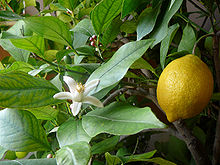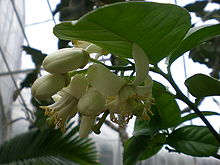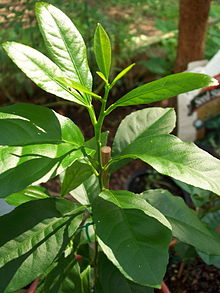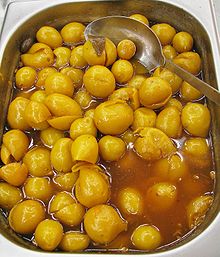- Lemon
-
This article is about the fruit. For other uses, see Lemon (disambiguation).
Lemon 
Scientific classification Kingdom: Plantae (unranked): Angiosperms (unranked): Eudicots (unranked): Rosids Order: Sapindales Family: Rutaceae Genus: Citrus Species: C. × limon Binomial name Citrus × limon
(L.) Burm.f.The lemon is both a small evergreen tree (Citrus × limon, often given as C. limon) native to Asia, and the tree's oval yellow fruit. The fruit is used for culinary and nonculinary purposes throughout the world – primarily for its juice, though the pulp and rind (zest) are also used, mainly in cooking and baking. Lemon juice is about 5% to 6% (approximately 0.3 M) citric acid, which gives lemons a sour taste, and a pH of 2–3. Many lemon-flavored drinks and candies are available, including lemonade and sherbet lemons. The distinctive sour taste of lemon juice makes it a key ingredient in many dishes across the world.
Contents
History
The exact origin of the lemon has remained a mystery, though it is widely presumed that lemons first grew in India, northern Burma, and China.[1][2] In South and South East Asia, it was known for its antiseptic properties and it was used as an antidote for various poisons. Lemons entered Europe (near southern Italy) no later than the 1st century AD, during the time of Ancient Rome. However, they were not widely cultivated. It was later introduced to Persia and then to Iraq and Egypt around AD 700. The lemon was first recorded in literature in a 10th century Arabic treatise on farming, and was also used as an ornamental plant in early Islamic gardens.[1][2] It was distributed widely throughout the Arab world and the Mediterranean region between AD 1000 and AD 1150. The genetic origin of the lemon, however, was reported to be hybrid between sour orange and citron.[3]
The first substantial lemon cultivation in Europe began in Genoa in the middle of the 15th century.[2] It was later introduced to the Americas in 1493 when Christopher Columbus brought lemon seeds to Hispaniola along his voyages. Spanish conquest throughout the New World helped spread lemon seeds. It was mainly used as ornament and medicine.[2] In the 18th and 19th centuries, lemons were increasingly planted in Florida and California, when lemons began to be used in cooking and flavoring.[4]
In 1747, James Lind's experiments on seamen suffering from scurvy involved adding vitamin C to their diets with lemon juice.[5]
The etymological path of the word lemon suggests a Middle Eastern origin. One of the earliest occurrences of "lemon" is found in a Middle English customs document of 1420–1421, which draws from the Old French limon, thence the Italian limone, from the Arabic laymūn or līmūn, from the Persian līmūn.[6]
Varieties
- Bush lemon tree
- This naturalized lemon grows wild in subtropical Australia. They are very hardy, and have a thick skin with a true lemon flavor; the zest is good for cooking. It grows to about 4m in a sunny position.
- Eureka[7]
- Because it grows year-round and abundantly, this is the common supermarket lemon.[8]
- Lisbon[9]
- A good quality bitter lemon with high juice and acid levels, the fruits of Lisbon are very similar to Eureka. The vigorous and productive trees are very thorny, particularly when young.
- This is a cross between a lemon and possibly an orange or a mandarin, and was named for Frank N. Meyer, who first discovered it in 1908. Thin-skinned and slightly less acidic than the Lisbon and Eureka lemons, Meyer lemons require more care when shipping and are not widely grown on a commercial basis. Meyer lemons have a much thinner rind, and often mature to a yellow-orange color. Meyer lemons are slightly more frost-tolerant than other lemons.
- Ponderosa[11]
- The tree is very hardy and can handle frosts; the fruit are thick-skinned and very large. Likely a citron-lemon hybrid.
- Variegated Pink[12]
- A varietal of the eureka or lisbon cultivars with variegated patterns in the foliage and the rinds of immature green fruit. Upon maturing to yellow, the variegated patter recedes in the fruit rind. The flesh and juice are pink or pinkish-orange instead of yellow.
- Verna
- A Spanish variety of unknown origin[13]
- Villafranca[14]
- Yen Ben
- An Australasian cultivar[15]
- Cultivated in Japan and Korea for centuries, yuzu have a flavor akin to a mixture of meyer lemon and white grapefruit. Yuzu is likely a wild hybrid between an ichang papeda and a sour mandarin, and is a close relative of sudachi and kaffir limes. Yuzu rival citranges and kumquats as the most cold-tolerant citrus.
Nutritional value
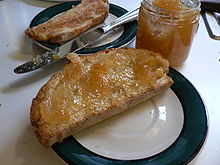 Lemon marmalade on a slice of bread
Lemon marmalade on a slice of bread
The average lemon contains approximately 3 tablespoons of juice. Allowing lemons to come to room temperature before squeezing (or heating briefly in a microwave) makes the juice easier to extract. Lemons left unrefrigerated for long periods of time are susceptible to mold.
Lemon, raw, without peel Nutritional value per 100 g (3.5 oz) Energy 121 kJ (29 kcal) Carbohydrates 9.32 g - Sugars 2.50 g - Dietary fiber 2.8 g Fat 0.30 g Protein 1.10 g Thiamine (vit. B1) 0.040 mg (3%) Riboflavin (vit. B2) 0.020 mg (2%) Niacin (vit. B3) 0.100 mg (1%) Pantothenic acid (B5) 0.190 mg (4%) Vitamin B6 0.080 mg (6%) Folate (vit. B9) 11 μg (3%) Vitamin C 53.0 mg (64%) Calcium 26 mg (3%) Iron 0.60 mg (5%) Magnesium 8 mg (2%) Phosphorus 16 mg (2%) Potassium 138 mg (3%) Zinc 0.06 mg (1%) Percentages are relative to US recommendations for adults.
Source: USDA Nutrient DatabaseCulinary uses
Lemon juice, rind, and zest are used in a wide variety of culinary applications:
- Lemon juice is used to make lemonade, soft drinks, and marinades for both fish, where its acid neutralizes amines in fish by converting them into nonvolatile ammonium salts, and meat, where the acid partially hydrolyzes tough collagen fibers, tenderizing the meat, but the low pH denatures the proteins, causing them to dry out when cooked.
Lemon juice is also used as a short-term preservative on certain foods that tend to oxidize and turn brown after being sliced, such as apples, bananas and avocados, where its acid denatures the enzymes which cause browning and degradation. Lemon juice and rind are used to make marmalade and lemon liqueur.
- Lemon slices and lemon rind are used a garnish for both food and drinks.
- Lemon zest, the grated outer rind of the fruit, is used to add flavor to baked goods, puddings, rice and other dishes.
- Pickled lemons are a Moroccan delicacy.
Nonculinary uses
Aromatherapy, first aid and medicine
- In one of the most comprehensive scientific investigations done yet, researchers at The Ohio State University revealed lemon oil aroma used in aromatherapy does not influence the human immune system, but may enhance mood.[17]
- The low pH of juice makes it antibacterial.
Commercial use
- Lemons were the primary commercial source of citric acid prior to the development of fermentation-based processes.
- A halved lemon is used as a finger moistener for those counting large amounts of bills, such as tellers and cashiers.
Household use
- The peel oil is used as a wood cleaner and polish, where the solvent property of d-limonene is employed to dissolve old wax, fingerprints, and grime.
- A halved lemon dipped in salt or baking powder can be used to brighten copper cookware. The acid dissolves the tarnish and the abrasives assist the cleaning.
- As a sanitary kitchen deodorizer the juice can deodorize, remove grease, bleach stains, and disinfect; when mixed with baking soda, it can remove stains from plastic food storage containers.[18]
Insecticide
- The d-limonene in lemon oil is used as a nontoxic insecticide treatment. See orange oil.
Science education
- A popular science experiment in schools involves attaching electrodes to a lemon and using it as a battery to produce electricity. Although very low power, several lemon batteries can power a small digital watch.[19] These experiments also work with other fruits and vegetables.
- Lemon juice is sometimes used as an acid in educational science experiments.
Lemon alternatives
Many plants are noted to taste or smell similar to lemons.
- Certain cultivars of basil
- Cymbopogon (lemon grass)
- Lemon balm, a hybrid Pelargonium x melissinum (scented "geranium")
- Lemongrass
- Lemon myrtle, recently, this Australian bush food has become a popular alternative to lemons.[20] The crushed and dried leaves and edible essential oils have a strong, sweet lemon taste, but contain no citric acid. Lemon myrtle is popular in foods that curdle with lemon juice, such as cheesecake and ice cream.
- Lemon thyme
- Lemon verbena
- Limes are often used instead of lemons.[citation needed]
- Certain cultivars of mint
Production
India tops the production list with about 16% of the world's overall lemon and lime output, followed by Mexico (~14.5%), Argentina (~10%), Brazil (~8%) and Spain (~7%).
Top Ten Lemons and Limes Producers – 2007 Country Production (Tonnes)  India
India2,060,000F  Mexico
Mexico1,880,000F  Argentina
Argentina1,260,000F  Brazil
Brazil1,060,000F  Spain
Spain880,000F  People's Republic of China
People's Republic of China745,100F  United States
United States722,000  Turkey
Turkey706,652  Iran
Iran615,000F  Italy
Italy546,584 World 13,032,388F No symbol = official figure, F = FAO estimate, A = Aggregate (may include official, semi-official or estimates);
References
- ^ a b Wright, A. Clifford. History of Lemonade, CliffordAWright.com
- ^ a b c d The origins, limmi.it.
- ^ Gulsen, O.; M. L. Roose (2001). "Lemons: Diversity and Relationships with Selected Citrus Genotypes as Measured with Nuclear Genome Markers". Journal of the American Society of Horticultural Science, 126:309–317
- ^ Morton, J. 1987. Lemon. p. 160–168. Fruits of warm climates. (Julia F. Morton, Miami, FL.) @ Purdue University
- ^ Case 3: Naval Medicine: The Fight Against Scurvy @ King's College at London. Information on this site is based from: James Lind. A treatise on the scurvy. Second edition. London: printed for A. Millar, 1757. [St. Thomas's Historical Collection 28.b.9].
- ^ Dictionary.com
- ^ Photo
- ^ "Complete List of Four Winds Dwarf Citrus Varieties". Fourwindsgrowers.com. http://www.fourwindsgrowers.com/variety_list.html#lemon. Retrieved 2010-06-06.
- ^ Photo
- ^ Photo
- ^ Photo
- ^ Photo
- ^ Australiancitrusgrowers.com[dead link]
- ^ "The Circle | Channel Ten". 9am.ten.com.au. http://9am.ten.com.au/lemon-trees.htm. Retrieved 2010-06-06.
- ^ "New Zealand Citrus". ceventura.ucdavis.edu. http://ceventura.ucdavis.edu/ben/citrus/misc/new_zealand.htm. Retrieved 2010-06-13.
- ^ Photo
- ^ 9 Ohio State University Research, March 3, 2008 Study is published in the March 2008 issue of the journal Psychoneuroendocrinology
- ^ 6 ingredients for a green, clean home, Shine. Retrieved on April 24, 2008.
- ^ Energyquest.ca.gov California Energy Commission
- ^ Lemon Myrtle
External links
- (Purdue University) Morton, Julia F. 1987. "Lemon". pp. 160–168, in Fruits of warm climates. (Julia F. Morton, Miami)
- PlantFiles: Citrus x meyeri 'Meyer'
- When LIFE Hands You Lemons – slideshow by Life magazine
Citrus Important species Citron • Key lime • Persian lime • Mandarin orange • Pomelo
Important cultivars Bitter orange • Clementine • Grapefruit • Lemon • Lime • Orange • Rangpur • Tangerine • Naartjie
Other topics  Book:Citrus ·
Book:Citrus ·  Category:CitrusCategories:
Category:CitrusCategories:- Hybrid Citrus
- Tropical agriculture
- Persian loanwords
Wikimedia Foundation. 2010.

